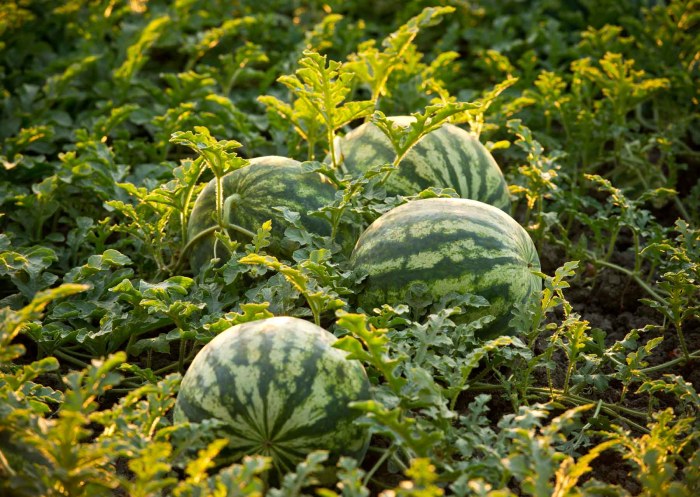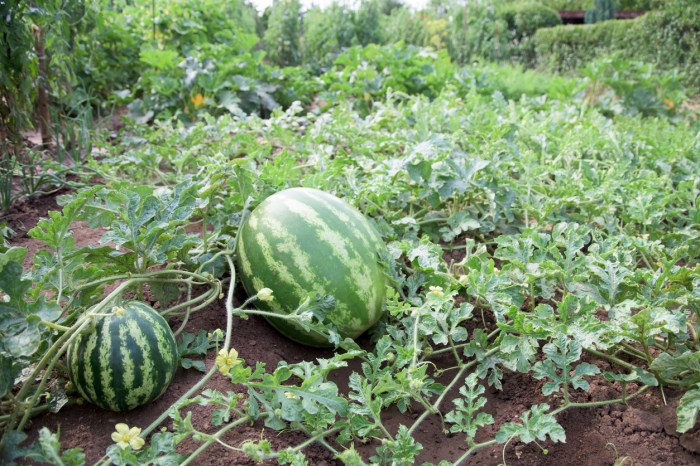How to Plant Watermelon from Seeds A Gardeners Guide
Sowing Watermelon Seeds
How to plant watermelon from seeds – Successfully sowing watermelon seeds is paramount to a bountiful harvest. The process requires careful consideration of several factors, including seed depth, spacing, and protection from environmental threats. These seemingly small details significantly impact germination rates and the overall health of the plants.Proper seed depth and spacing are crucial for optimal germination and growth. Planting too shallowly exposes seeds to desiccation and predation, while planting too deeply can hinder emergence.
Similarly, overcrowding leads to competition for resources, resulting in smaller, less productive plants.
Seed Depth and Spacing Recommendations
Watermelon seeds should be planted approximately 1 inch (2.5 cm) deep. This depth provides sufficient protection from the elements while allowing easy emergence for the seedlings. Spacing between seeds should be 2-3 feet (60-90 cm) apart within rows, with rows spaced 4-6 feet (120-180 cm) apart. This spacing allows for adequate air circulation, sunlight penetration, and root development, minimizing competition for nutrients and water.
Larger varieties may require even greater spacing. For example, a large-fruited variety like ‘Crimson Sweet’ might benefit from spacing of up to 4 feet between plants. Smaller varieties, such as ‘Sugar Baby’, could be spaced slightly closer, though maintaining at least 2 feet is recommended.
Protecting Seeds from Pests and Birds
Protecting watermelon seeds from pests and birds is crucial for ensuring successful germination. Birds are particularly attracted to the seeds, readily consuming them before they have a chance to sprout. Small mammals can also be a problem, digging up seeds or damaging young seedlings. Several strategies can be employed to mitigate these risks. Row covers, lightweight fabrics draped over the planted rows, offer excellent protection against birds and some insects.
These allow sunlight and water to penetrate while creating a barrier against pests. Another effective method is to use seed starting trays or containers initially, planting the seedlings outdoors once they have established a strong root system and are larger and less vulnerable. Lastly, strategically placed bird netting or scarecrows can deter birds from foraging in the planting area.
The netting needs to be finely woven to prevent birds from reaching through.
Watering and Maintaining Young Seedlings

Water management is critical during the early stages of watermelon growth. Insufficient or excessive watering can severely impact seedling establishment and overall yield. Careful observation and a consistent approach are key to nurturing healthy young plants. This section details the optimal watering practices and addresses common problems encountered during this phase.Consistent moisture is essential for successful germination and early growth.
However, overwatering can lead to root rot and fungal diseases, while underwatering results in wilting and stunted growth. Finding the right balance requires understanding the specific needs of watermelon seedlings and adapting to environmental conditions.
Watering Schedule for Watermelon Seedlings, How to plant watermelon from seeds
Watermelon seedlings require regular watering, particularly during dry periods. The frequency depends on factors such as soil type, temperature, and sunlight exposure. A good rule of thumb is to keep the soil consistently moist but not waterlogged. Avoid letting the soil dry out completely, especially during the first few weeks after germination. Overwatering, however, can be equally detrimental.
Check the soil moisture regularly by inserting your finger a couple of inches into the soil. If the soil feels dry, it’s time to water. For sandy soils, more frequent watering may be needed compared to clay soils, which retain moisture for longer periods. In hot, sunny climates, increased watering may also be necessary.
Identifying and Addressing Watering Issues
Overwatering manifests as yellowing leaves, stunted growth, and a musty odor emanating from the soil. The seedlings may appear wilted even though the soil is wet. In contrast, underwatering leads to visibly wilted and droopy leaves. The leaves may curl and turn brown at the edges. The soil will be dry to the touch.
Successfully cultivating watermelons from seed requires careful attention to soil conditions and sunlight. Understanding the basics of seed germination, however, extends beyond just watermelons; the principles are similar even when considering the question, “how do i plant weed seeds,” as explored in this guide: how do i plant weed seeds. Ultimately, the success of any seed, whether watermelon or otherwise, hinges on providing the appropriate environment for growth.
Addressing overwatering involves allowing the soil to dry out slightly between waterings and improving drainage if necessary. For underwatering, immediate and thorough watering is crucial, followed by a more regular watering schedule.
Thinning Watermelon Seedlings
Overcrowding can lead to competition for resources, resulting in weaker plants and reduced yield. Thinning ensures that each seedling has enough space to develop a robust root system and healthy foliage. It’s essential to thin seedlings to the recommended spacing, usually 1-2 feet apart, depending on the variety.
The following steps Artikel the process of thinning watermelon seedlings:
- Assess the seedlings: Carefully examine the seedlings to identify the strongest and healthiest plants. Look for vigorous growth, dark green leaves, and absence of diseases or damage.
- Select plants to remove: Choose the weaker, smaller, or diseased seedlings for removal. Avoid damaging the remaining plants during this process.
- Remove unwanted seedlings: Gently pull out the selected seedlings from the soil, ensuring that you remove the entire root system to prevent regrowth. Do not pull on the remaining plants.
- Water the remaining seedlings: After thinning, water the remaining seedlings thoroughly to help them recover from the disturbance.
Illustrative Examples of Watermelon Growth Stages

Understanding the various growth stages of a watermelon plant is crucial for successful cultivation. Observing these stages allows for timely intervention, maximizing yield and fruit quality. The following provides a visual representation and detailed description of each key stage, along with ideal planting arrangements.
Watermelon Growth Stages: A Visual Representation
Imagine a series of images depicting the watermelon’s life cycle. The first image shows a small, dark brown watermelon seed, barely visible to the naked eye. The second shows a seedling, a tiny sprout emerging from the soil, with a pair of delicate cotyledons (seed leaves). The third image showcases a young plant with several true leaves, exhibiting vigorous growth.
The fourth shows the plant developing tendrils, extending across the ground or climbing a support. The fifth displays the appearance of small, immature watermelons, barely larger than golf balls. The sixth depicts larger, developing watermelons, exhibiting their characteristic striped pattern. The final image shows a mature watermelon, ready for harvest, its rind fully developed and exhibiting a deep, rich color.
This progression highlights the plant’s remarkable transformation from a tiny seed to a large, juicy fruit.
Ideal Spacing and Arrangement of Watermelon Plants
Efficient spacing is critical for optimal watermelon growth and yield. Overcrowding leads to competition for resources, resulting in smaller fruit and reduced overall yield. Conversely, excessive spacing wastes valuable garden space. The ideal arrangement typically involves planting watermelon seeds or seedlings in hills, allowing for ample space between each hill. A common arrangement is a spacing of 4-6 feet between hills, allowing for adequate vine growth and sunlight penetration.
Within each hill, 3-4 seeds or seedlings can be planted, thinned later to the strongest plant. This arrangement maximizes space utilization while ensuring each plant receives sufficient sunlight, water, and nutrients. Consider a rectangular garden bed, with hills arranged in rows, maintaining the specified spacing between hills and rows. This arrangement facilitates efficient irrigation and harvesting. For instance, a 10ft x 10ft garden bed could accommodate approximately 4 hills, depending on the spacing chosen.
Proper spacing ensures that each plant has enough space to develop its extensive root system and sprawling vines, maximizing fruit production.
User Queries: How To Plant Watermelon From Seeds
What if my watermelon seeds don’t germinate?
Several factors can affect germination. Ensure your seeds are viable (test them!), the soil is properly prepared, and the temperature is suitable. Insufficient watering or overly compacted soil can also hinder germination. Try again with fresh seeds and optimal conditions.
How do I know when my watermelon is ripe?
A ripe watermelon will have a dull, rather than shiny, skin. The bottom will be a creamy yellow color. When you thump it, it will have a deep, hollow sound. The tendrils near the stem will be brown and dry.
What are some common watermelon pests?
Aphids, squash bugs, and spider mites are common watermelon pests. Regularly inspect your plants and use appropriate organic pest control methods if necessary. Companion planting can also help deter pests.
Can I save seeds from my harvested watermelons?
Yes, but it’s best to select seeds from the healthiest and most desirable fruits. Let the fruit fully ripen on the vine. Clean the seeds, dry them thoroughly, and store them in a cool, dry place.



